- 1Andorid SDK Manager详解_manage andorid sdk
- 2深度探索:机器学习中的序列到序列模型(Seq2Seq)原理及其应用
- 3SpringCloud(Ribbon,Feign,Hystrix,Gateway,GlobalFilter)_feignclient sentinel globalfilter
- 4vue和SpringBoot搭建项目(原创)_vue+springboot项目创建
- 5关于mysql的无符号数据类型_无符号的decimal
- 6智能化农业设备管理:引领未来农业,让你的农业设备运转如行云流水!
- 7linux的重要知识点_linux中的重要知识点
- 8python 海龟交易法则_【手把手教你】用Python量化海龟交易法则
- 9现代IC/LSI工艺PCB封装大全
- 10在Linux系统yum安装报错Cannot find a valid baseurl for repo解决方案_error: cannot find a valid baseurl for repo: livna
【Java】java实现文件上传和下载(上传到指定路径/数据库/minio)_java 上传文件
赞
踩
目录
MultipartFile接收前端传递的文件:127.0.0.1:8082/path/uploadFile
part接收前端传递的文件:127.0.0.1:8082/path/uploadFileByRequest
业务分析:实际开发过程中,我们经常对文件的上传和下载的功能实现,所以这也是一个程序员应该掌握的基本开发能力。所以下面我给大家分享一下文件上传和下载的三种方式,分别将文件上传到指定路径下/本地数据库/minio当中。
所有代码都以上传至压缩包资源,可以自行免费进行下载测试;
所有application.yml为:
- # MyBatis
- mybatis:
- mapper-locations: classpath*:mapper/*.xml
- server:
- port: 8888
- spring:
- application:
- name: user-service
- datasource:
- url: jdbc:mysql://127.0.0.1:3306/xxx
- username: root
- password: xxx
- driver-class-name: com.mysql.cj.jdbc.Driver
-
- # Redis
- data:
- redis:
- port: 6379
- username:
- password:
- host: 127.0.0.1
- # Minio
- minio:
- access-key: "username"
- secret-key: "password"
- end-point: "http://127.0.0.1:9000/"
- bucket: "playedu"
- domain: "http://127.0.0.1:9000/"
上传到指定路径
一、代码层级结构
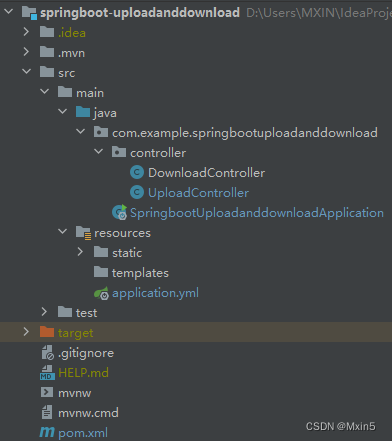
二、文件上传接口
- /**
- * 上传到指定路径下
- */
- @RestController
- @Slf4j
- @RequestMapping("/path")
- public class UploadController {
-
- @Autowired
- private ResourceLoader resourceLoader;
-
-
- private BufferedOutputStream bufferedOutputStream = null;
-
-
- /**
- * form-data 类型
- * form-data 类型即常用的表单提交
- * 两种处理参数的方式
- * <p>
- * MultipartFile 类接受前台传过来的文件
- * part 接收字节流
- */
- @PostMapping("/uploadFile")
- public String uploadFile(@RequestParam("name") String name, @RequestPart("file1") MultipartFile file1, @RequestPart("file2") MultipartFile[] file2) throws IOException, ServletException {
-
-
- // 获取项目部署路径
- /* String appPath = request.getServletContext().getRealPath("/");
- // 构建上传文件的目录路径
- String path = appPath + "static/upload/";*/
-
- //绝对路劲
- // String path = "D:\\Users\\MXIN\\IdeaProjects\\springboot-uploadanddownload\\src\\main\\resources\\static\\";
- //相对路径
- String path = "src/main/resources/static/";
-
- //前端传递多个file(只对file2进行处理)
- for (MultipartFile multipartFile : file2) {
- // 使用 MultipartFile 字节流保存文件
- fileUtil(multipartFile, String.valueOf(path));
- }
- fileUtil(file1, String.valueOf(path));
-
- return "success";
- }
-
- /**
- * part 接收字节流
- */
- @PostMapping("/uploadFileByRequest")
- public String uploadFileByRequest(HttpServletRequest request) throws IOException, ServletException {
- // 获取项目部署路径
- /* String appPath = request.getServletContext().getRealPath("/");
- // 构建上传文件的目录路径
- String path = appPath + "static/upload/";*/
-
- //绝对路劲
- String path = "D:\\Users\\MXIN\\IdeaProjects\\springboot-uploadanddownload\\src\\main\\resources\\static\\";
-
-
- // 使用 Part 接收文件字节流
- // Part file1 = request.getPart("file1");
- // file1.write(path + file1.getSubmittedFileName());
-
- // request.getParts() 获取的是全部参数(name,age,file1,file2),包括文件参数和非文件参数
- for (Part part : request.getParts()) {
- // 获取文件类型
- String contentType = part.getContentType();
- // 获取文件大小
- long size = part.getSize();
- // 获取文件名
- String submittedFileName = part.getSubmittedFileName();
-
- if (part.getContentType() != null) {
- //如果是文件会进行写入
- part.write(path + part.getSubmittedFileName());
- } else {
- // 如果是参数会获取参数(根据实际需求对参数进行处理)
- // 获取参数名
- String name1 = part.getName();
- }
- }
- return "success";
- }
-
-
- public String fileUtil(MultipartFile file, String path) {
-
- if (!file.isEmpty()) {
- try {
- byte[] bytes = file.getBytes();
- bufferedOutputStream = new BufferedOutputStream(new FileOutputStream(
- new File(path + file.getOriginalFilename())));
- bufferedOutputStream.write(bytes);
- bufferedOutputStream.close();
- return file.getOriginalFilename() + "上传成功";
- } catch (Exception e) {
- return file.getOriginalFilename() + "上传失败,错误信息为:" + e;
- }
- } else {
- return "上传得文件为空";
- }
- }
-
-
- }
三、使用postman进行测试;
MultipartFile接收前端传递的文件:127.0.0.1:8082/path/uploadFile

测试结果
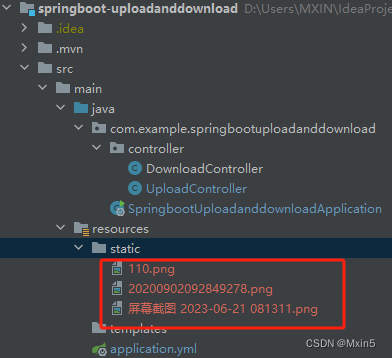
part接收前端传递的文件:127.0.0.1:8082/path/uploadFileByRequest
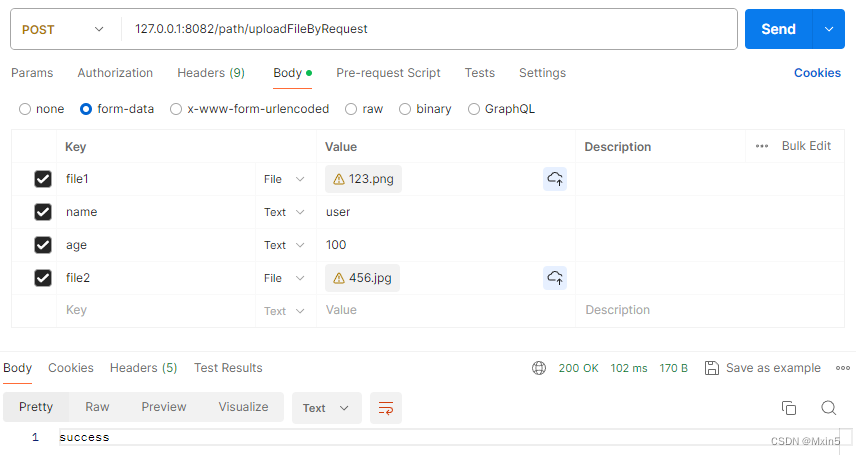
测试结果
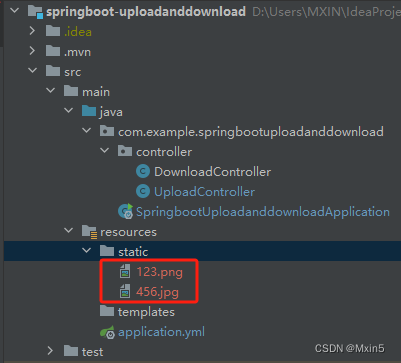
四、上传文件大小设置
由于springboot默认上传文件大小为1M,单个请求最大为10M,当文件超过1M会报错。所以可以通过配置文件限制文件上传大小。
上传大于1M报错信息为:
![]()
Resolved [org.springframework.web.multipart.MaxUploadSizeExceededException: Maximum upload size exceeded]所以修改配置文件(根据自己实际开发需求进行修改):
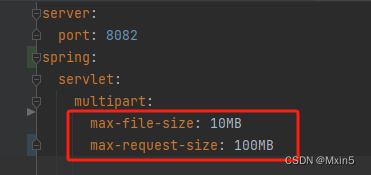
上述简单的介绍了文件上传到指定路径下的方法,下面来简单介绍一下文件下载是如何实现的。
五、文件下载接口
- /**
- * 下载指定路径下的文件
- * */
- @RestController
- @Slf4j
- @RequestMapping("/path")
- public class DownloadController {
-
- /**
- * 文件下载 isOnline默认为false
- */
- @GetMapping("/download")
- public void download(String fileName, HttpServletResponse response, boolean isOnLine) throws IOException {
- // 路径可以指定当前项目相对路径
- File file = new File("D:\\Users\\Mixi\\IdeaProjects\\springboot-uploadanddownload\\src\\main\\resources\\static\\" + fileName);
- if (file.exists()) {
- FileInputStream fileInputStream = new FileInputStream(file);
- ServletOutputStream outputStream = response.getOutputStream();
-
- // 获取文件扩展名
- String extension = fileName.substring(fileName.lastIndexOf(".") + 1);
-
- if (!isOnLine) {
- // 根据文件扩展名设置Content-Type
- String contentType = getContentType(extension);
- response.setContentType(contentType);
-
- // 如果文件名为中文需要设置编码
- response.setHeader("Content-Disposition", "attachment;fileName=" + URLEncoder.encode(fileName, "utf8"));
- // 返回前端文件名需要添加
- response.setHeader("Access-Control-Expose-Headers", "Content-Disposition");
- }
- byte[] bytes = new byte[1024];
- int len;
- while ((len = fileInputStream.read(bytes)) != -1) {
- outputStream.write(bytes, 0, len);
- }
- }
- }
-
- // 根据文件扩展名获取Content-Type
- private String getContentType(String extension) {
- if ("jpg".equalsIgnoreCase(extension) || "jpeg".equalsIgnoreCase(extension)) {
- return "image/jpeg";
- } else if ("png".equalsIgnoreCase(extension)) {
- return "image/png";
- } else if ("gif".equalsIgnoreCase(extension)) {
- return "image/gif";
- } else if ("txt".equalsIgnoreCase(extension)) {
- return "text/plain";
- } else if ("pdf".equalsIgnoreCase(extension)) {
- return "application/pdf";
- } else if ("doc".equalsIgnoreCase(extension) || "docx".equalsIgnoreCase(extension)) {
- return "application/msword";
- } else if ("xls".equalsIgnoreCase(extension) || "xlsx".equalsIgnoreCase(extension)) {
- return "application/vnd.ms-excel";
- } else if ("ppt".equalsIgnoreCase(extension) || "pptx".equalsIgnoreCase(extension)) {
- return "application/vnd.ms-powerpoint";
- } else if ("zip".equalsIgnoreCase(extension)) {
- return "application/zip";
- } else if ("tar".equalsIgnoreCase(extension)) {
- return "application/x-tar";
- } else if ("rar".equalsIgnoreCase(extension)) {
- return "application/x-rar-compressed";
- } else if ("gz".equalsIgnoreCase(extension)) {
- return "application/gzip";
- } else {
- return "application/octet-stream";
- }
- }
- }
六、使用postman进行测试
isOnlie为true和false决定了是否在浏览器上在线查看。
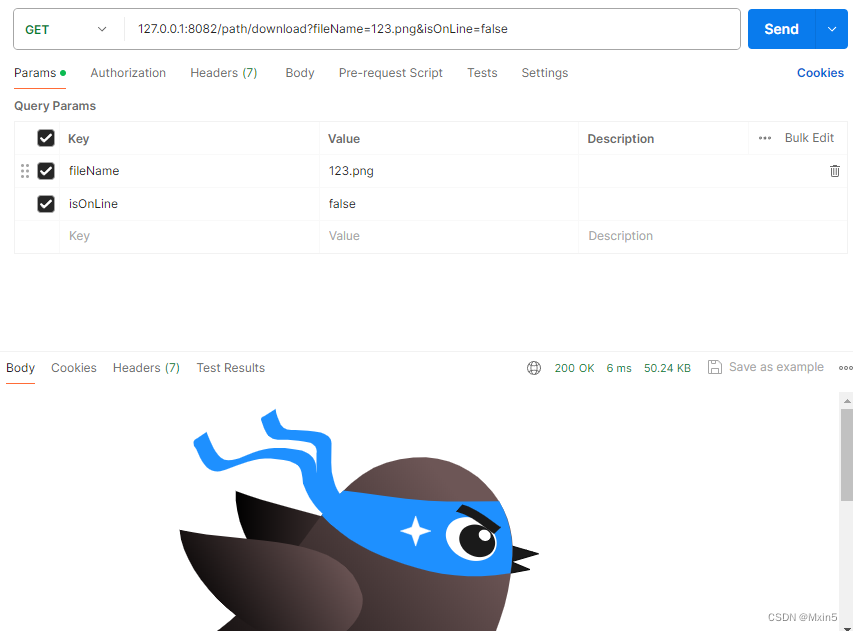
上传至数据库
这种业务需求就是用于项目开发过程中,文件上传下载的功能用的很少,避免搭建部署文件存储的服务器,简化了部署和管理,节约成本资源。
一、代码层级结构
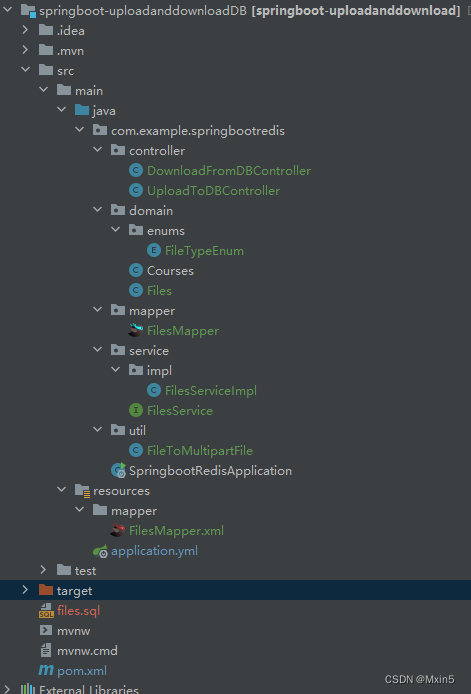
二、文件上传接口
UploadToDBController:
- /**
- * 上传到数据库
- * */
- @RestController
- @Slf4j
- @RequestMapping("/db")
- public class UploadToDBController {
-
- @Autowired
- private FilesService filesService;
-
-
- @PostMapping("/uploadFile")
- public Files inputFile(@RequestParam("file") MultipartFile file) {
-
- Files files = new Files();
- if (null != file) {
- String name = file.getOriginalFilename();
- byte[] bytes;
- try {
- bytes = file.getBytes();
- } catch (IOException e) {
- throw new RuntimeException(e);
- }
- files.setName(name);
- files.setFile(bytes);
- filesService.save(files);
- }
- return files;
- }
- }
FilesServiceImpl:
- @Override
- public void save(Files files) {
- filesMapper.insert(files);
- }
简单代码的增删改查我就不写了哈。
三、文件下载接口
DownloadFromDBController:
- /**
- * 从数据库下载
- */
- @RestController
- @Slf4j
- @RequestMapping("/db")
- public class DownloadFromDBController {
-
- @Autowired
- private FilesService filesService;
-
- @GetMapping("/download/{id}")
- public void download(HttpServletResponse response, @PathVariable("id") Integer id) {
- filesService.download(response,id);
- }
- }
FilesServiceImpl:
- @Override
- public HttpServletResponse download(HttpServletResponse response, Integer id) {
- try {
- byte[] buf;
- Files byId = filesMapper.selectById(id);
- if (byId == null) {
- return response;
- }
- buf = byId.getFile();
- String suffix = FileToMultipartFile.getSuffix(byId.getName());
- String contentType = "";
- switch (Objects.requireNonNull(FileTypeEnum.getEnum(suffix))) {
- case DOC:
- contentType = "application/msword";
- break;
- case DOCX:
- contentType = "application/vnd.openxmlformats-officedocument.wordprocessingml.document";
- break;
- case PDF:
- contentType = "application/powerpoint";
- break;
- case JPE:
- case JPG:
- case JPEG:
- contentType = "image/jpeg";
- break;
- case PNG:
- contentType = "image/png";
- break;
- case ZIP:
- contentType = "application/zip";
- break;
- case TAR:
- contentType = "application/x-tar";
- break;
- case GZ:
- contentType = "application/x-gzip";
- break;
- case XLS:
- contentType = "application/vnd.ms-excel";
- break;
- case XLSX:
- contentType = "application/vnd.openxmlformats-officedocument.spreadsheetml.sheet";
- break;
- case PPT:
- contentType = "application/vnd.ms-powerpoint";
- break;
- case PPTX:
- contentType = "application/vnd.openxmlformats-officedocument.presentationml.presentation";
- break;
- }
-
- // 清空
- response.reset();
- String encodedFileName = URLEncoder.encode(byId.getName().replaceAll(" ", "+"), "UTF-8");
- // 设置header
- response.addHeader("Content-Disposition", "attachment;filename=" + encodedFileName);
- // response.addHeader("Content-Length", "" + byId.getFileNo());
- response.setCharacterEncoding("UTF-8");
- response.setContentType(contentType);
- response.getOutputStream().write(buf);
- // 强制输出,不然会留在内存里丢失掉
- response.getOutputStream().flush();
- return response;
- } catch (Exception e) {
- throw new RuntimeException(e);
- }
- }
四、使用postman进行测试
文件上传:
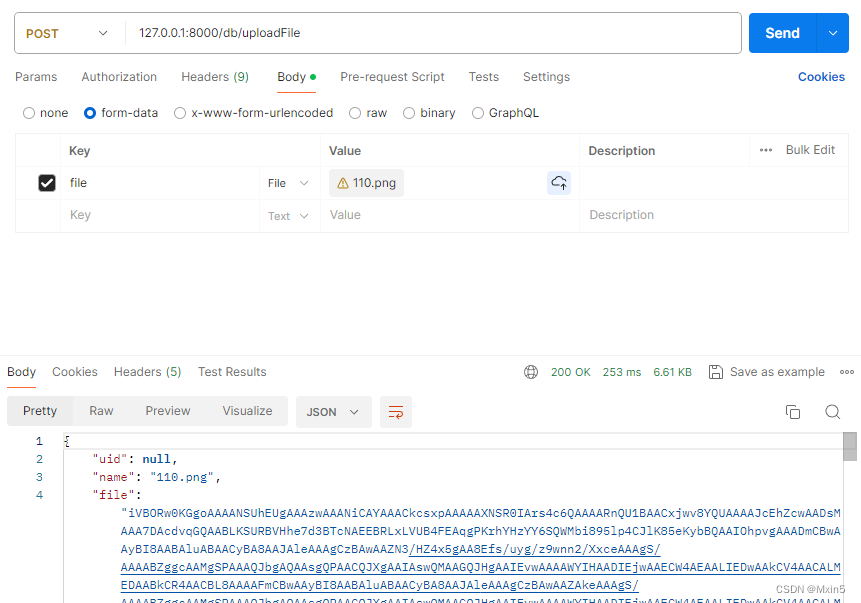
测试结果数据库:

文件下载:
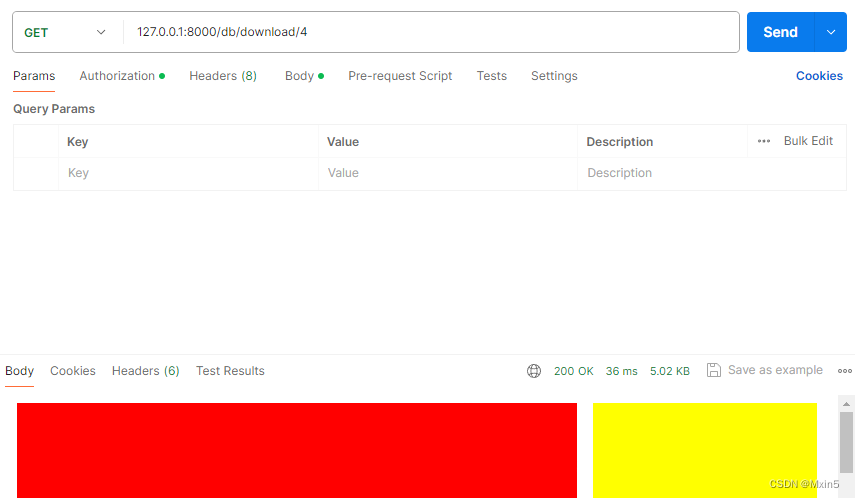
测试结果:

上传至Minio
首先要在本地或者服务器上部署minio并启动才可以进行文件的上传和下载,还未安装minio的可以参考一下这篇文章:【Docker】手把手教你在windows使用Docker安装Minio[详细教程]_minio windows-CSDN博客
一、代码层级结构

二、文件上传/下载接口
- /**
- * 文件上传、下载、删除、获取文件信息、获取文件url接口
- * */
- @Slf4j
- @RestController
- @RequestMapping("/oss")
- public class MinioController {
-
- @Autowired
- private MinioUtils minioUtils;
-
- @Autowired
- private MinioConfig minioConfig;
-
- /**
- * 文件上传
- *
- * @param file
- */
- @PostMapping("/upload")
- public String upload(@RequestParam("file") MultipartFile file) {
- try {
- //文件名
- String fileName = file.getOriginalFilename();
- String newFileName = System.currentTimeMillis() + "." + StringUtils.substringAfterLast(fileName, ".");
- //类型
- String contentType = file.getContentType();
- minioUtils.uploadFile(minioConfig.getBucketName(), file, newFileName, contentType);
- return "上传成功,文件名:" + newFileName;
- } catch (Exception e) {
- e.printStackTrace();
- return "上传失败";
- }
- }
-
- /**
- * 删除
- *
- * @param fileName
- */
- @DeleteMapping("/")
- public void delete(@RequestParam("fileName") String fileName) {
- minioUtils.removeFile(minioConfig.getBucketName(), fileName);
- }
-
- /**
- * 获取文件信息
- *
- * @param fileName
- * @return
- */
- @GetMapping("/info")
- public String getFileStatusInfo(@RequestParam("fileName") String fileName) {
- return minioUtils.getFileStatusInfo(minioConfig.getBucketName(), fileName);
- }
-
- /**
- * 获取文件外链
- *
- * @param fileName
- * @return
- */
- @GetMapping("/url")
- public String getPresignedObjectUrl(@RequestParam("fileName") String fileName) {
- return minioUtils.getPresignedObjectUrl(minioConfig.getBucketName(), fileName);
- }
-
- /**
- * 文件下载
- *
- * @param fileName
- * @param response
- */
- @GetMapping("/download")
- public void download(@RequestParam("fileName") String fileName, HttpServletResponse response) {
- try {
- InputStream fileInputStream = minioUtils.getObject(minioConfig.getBucketName(), fileName);
- response.setHeader("Content-Disposition", "attachment;filename=" + fileName);
- response.setContentType("application/force-download");
- response.setCharacterEncoding("UTF-8");
- IOUtils.copy(fileInputStream, response.getOutputStream());
- } catch (Exception e) {
- log.error("下载失败");
- }
- }
- }
MinioUtils
- @Slf4j
- @Component
- public class MinioUtils {
-
- @Autowired
- private MinioClient minioClient;
-
-
- /**
- * 启动SpringBoot容器的时候初始化Bucket
- * 如果没有Bucket则创建
- *
- * @param bucketName
- */
- public void createBucket(String bucketName) {
- try {
- if (!bucketExists(bucketName)) {
- minioClient.makeBucket(MakeBucketArgs.builder().bucket(bucketName).build());
- log.info("创建bucketName = {}完成!", bucketName);
- return;
- }
- log.info("bucketName = {}已存在!策略为:{}", bucketName, getBucketPolicy(bucketName));
- } catch (Exception e) {
- log.error("创建bucketName = {}异常!e = {}", bucketName, e);
- }
- }
-
- /**
- * 判断Bucket是否存在,true:存在,false:不存在
- *
- * @param bucketName
- * @return
- */
- @SneakyThrows
- public boolean bucketExists(String bucketName) {
- return minioClient.bucketExists(BucketExistsArgs.builder().bucket(bucketName).build());
- }
-
- /**
- * 获得Bucket的策略
- *
- * @param bucketName
- * @return
- */
- @SneakyThrows
- public String getBucketPolicy(String bucketName) {
- return minioClient.getBucketPolicy(GetBucketPolicyArgs.builder().bucket(bucketName).build());
- }
-
- /**
- * 获得所有Bucket列表
- *
- * @return
- */
- @SneakyThrows
- public List<Bucket> getAllBuckets() {
- return minioClient.listBuckets();
- }
-
- /**
- * 根据bucketName获取其相关信息
- *
- * @param bucketName
- * @return
- */
- @SneakyThrows(Exception.class)
- public Optional<Bucket> getBucket(String bucketName) {
- return getAllBuckets().stream().filter(b -> b.name().equals(bucketName)).findFirst();
- }
-
- /**
- * 根据bucketName删除Bucket,true:删除成功; false:删除失败,文件或已不存在
- *
- * @param bucketName
- * @throws Exception
- */
- @SneakyThrows(Exception.class)
- public void removeBucket(String bucketName) {
- minioClient.removeBucket(RemoveBucketArgs.builder().bucket(bucketName).build());
- }
-
-
- /**
- * 判断文件是否存在
- *
- * @param bucketName
- * @param objectName
- * @return
- */
- public boolean isObjectExist(String bucketName, String objectName) {
- boolean exist = true;
- try {
- minioClient.statObject(StatObjectArgs.builder().bucket(bucketName).object(objectName).build());
- } catch (Exception e) {
- log.error("[Minio工具类]>>>> 判断文件是否存在, 异常:", e);
- exist = false;
- }
- return exist;
- }
-
- /**
- * 判断文件夹是否存在
- *
- * @param bucketName
- * @param objectName
- * @return
- */
- public boolean isFolderExist(String bucketName, String objectName) {
- boolean exist = false;
- try {
- Iterable<Result<Item>> results = minioClient.listObjects(ListObjectsArgs.builder().bucket(bucketName).prefix(objectName).recursive(false).build());
- for (Result<Item> result : results) {
- Item item = result.get();
- if (item.isDir() && objectName.equals(item.objectName())) {
- exist = true;
- }
- }
- } catch (Exception e) {
- log.error("[Minio工具类]>>>> 判断文件夹是否存在,异常:", e);
- exist = false;
- }
- return exist;
- }
-
- /**
- * 根据文件前置查询文件
- *
- * @param bucketName 存储桶
- * @param prefix 前缀
- * @param recursive 是否使用递归查询
- * @return MinioItem 列表
- */
- @SneakyThrows(Exception.class)
- public List<Item> getAllObjectsByPrefix(String bucketName, String prefix, boolean recursive) {
- List<Item> list = new ArrayList<>();
- Iterable<Result<Item>> objectsIterator = minioClient.listObjects(ListObjectsArgs.builder().bucket(bucketName).prefix(prefix).recursive(recursive).build());
- if (objectsIterator != null) {
- for (Result<Item> o : objectsIterator) {
- Item item = o.get();
- list.add(item);
- }
- }
- return list;
- }
-
- /**
- * 获取文件流
- *
- * @param bucketName 存储桶
- * @param objectName 文件名
- * @return 二进制流
- */
- @SneakyThrows(Exception.class)
- public InputStream getObject(String bucketName, String objectName) {
- return minioClient.getObject(GetObjectArgs.builder().bucket(bucketName).object(objectName).build());
- }
-
- /**
- * 断点下载
- *
- * @param bucketName 存储桶
- * @param objectName 文件名称
- * @param offset 起始字节的位置
- * @param length 要读取的长度
- * @return 二进制流
- */
- @SneakyThrows(Exception.class)
- public InputStream getObject(String bucketName, String objectName, long offset, long length) {
- return minioClient.getObject(GetObjectArgs.builder().bucket(bucketName).object(objectName).offset(offset).length(length).build());
- }
-
- /**
- * 获取路径下文件列表
- *
- * @param bucketName 存储桶
- * @param prefix 文件名称
- * @param recursive 是否递归查找,false:模拟文件夹结构查找
- * @return 二进制流
- */
- public Iterable<Result<Item>> listObjects(String bucketName, String prefix, boolean recursive) {
- return minioClient.listObjects(ListObjectsArgs.builder().bucket(bucketName).prefix(prefix).recursive(recursive).build());
- }
-
- /**
- * 使用MultipartFile进行文件上传
- *
- * @param bucketName 存储桶
- * @param file 文件名
- * @param objectName 对象名
- * @param contentType 类型
- * @return
- */
- @SneakyThrows(Exception.class)
- public ObjectWriteResponse uploadFile(String bucketName, MultipartFile file, String objectName, String contentType) {
- InputStream inputStream = file.getInputStream();
- return minioClient.putObject(PutObjectArgs.builder().bucket(bucketName).object(objectName).contentType(contentType).stream(inputStream, inputStream.available(), -1).build());
- }
-
- /**
- * 图片上传
- *
- * @param bucketName
- * @param imageBase64
- * @param imageName
- * @return
- */
- public ObjectWriteResponse uploadImage(String bucketName, String imageBase64, String imageName) {
- if (!StringUtils.isEmpty(imageBase64)) {
- InputStream in = base64ToInputStream(imageBase64);
- String newName = System.currentTimeMillis() + "_" + imageName + ".jpg";
- String year = String.valueOf(new Date().getYear());
- String month = String.valueOf(new Date().getMonth());
- return uploadFile(bucketName, year + "/" + month + "/" + newName, in);
-
- }
- return null;
- }
-
- public static InputStream base64ToInputStream(String base64) {
- ByteArrayInputStream stream = null;
- try {
- byte[] bytes = Base64.getEncoder().encode(base64.trim().getBytes());
- stream = new ByteArrayInputStream(bytes);
- } catch (Exception e) {
- e.printStackTrace();
- }
- return stream;
- }
-
-
- /**
- * 上传本地文件
- *
- * @param bucketName 存储桶
- * @param objectName 对象名称
- * @param fileName 本地文件路径
- * @return
- */
- @SneakyThrows(Exception.class)
- public ObjectWriteResponse uploadFile(String bucketName, String objectName, String fileName) {
- return minioClient.uploadObject(UploadObjectArgs.builder().bucket(bucketName).object(objectName).filename(fileName).build());
- }
-
- /**
- * 通过流上传文件
- *
- * @param bucketName 存储桶
- * @param objectName 文件对象
- * @param inputStream 文件流
- * @return
- */
- @SneakyThrows(Exception.class)
- public ObjectWriteResponse uploadFile(String bucketName, String objectName, InputStream inputStream) {
- return minioClient.putObject(PutObjectArgs.builder().bucket(bucketName).object(objectName).stream(inputStream, inputStream.available(), -1).build());
- }
-
- /**
- * 创建文件夹或目录
- *
- * @param bucketName 存储桶
- * @param objectName 目录路径
- * @return
- */
- @SneakyThrows(Exception.class)
- public ObjectWriteResponse createDir(String bucketName, String objectName) {
- return minioClient.putObject(PutObjectArgs.builder().bucket(bucketName).object(objectName).stream(new ByteArrayInputStream(new byte[]{}), 0, -1).build());
- }
-
- /**
- * 获取文件信息, 如果抛出异常则说明文件不存在
- *
- * @param bucketName 存储桶
- * @param objectName 文件名称
- * @return
- */
- @SneakyThrows(Exception.class)
- public String getFileStatusInfo(String bucketName, String objectName) {
- return minioClient.statObject(StatObjectArgs.builder().bucket(bucketName).object(objectName).build()).toString();
- }
-
- /**
- * 拷贝文件
- *
- * @param bucketName 存储桶
- * @param objectName 文件名
- * @param srcBucketName 目标存储桶
- * @param srcObjectName 目标文件名
- */
- @SneakyThrows(Exception.class)
- public ObjectWriteResponse copyFile(String bucketName, String objectName, String srcBucketName, String srcObjectName) {
- return minioClient.copyObject(CopyObjectArgs.builder().source(CopySource.builder().bucket(bucketName).object(objectName).build()).bucket(srcBucketName).object(srcObjectName).build());
- }
-
- /**
- * 删除文件
- *
- * @param bucketName 存储桶
- * @param objectName 文件名称
- */
- @SneakyThrows(Exception.class)
- public void removeFile(String bucketName, String objectName) {
- minioClient.removeObject(RemoveObjectArgs.builder().bucket(bucketName).object(objectName).build());
- }
-
- /**
- * 批量删除文件
- *
- * @param bucketName 存储桶
- * @param keys 需要删除的文件列表
- * @return
- */
- public void removeFiles(String bucketName, List<String> keys) {
- List<DeleteObject> objects = new LinkedList<>();
- keys.forEach(s -> {
- objects.add(new DeleteObject(s));
- try {
- removeFile(bucketName, s);
- } catch (Exception e) {
- log.error("[Minio工具类]>>>> 批量删除文件,异常:", e);
- }
- });
- }
-
- /**
- * 获取文件外链
- *
- * @param bucketName 存储桶
- * @param objectName 文件名
- * @param expires 过期时间 <=7 秒 (外链有效时间(单位:秒))
- * @return url
- */
- @SneakyThrows(Exception.class)
- public String getPresignedObjectUrl(String bucketName, String objectName, Integer expires) {
- GetPresignedObjectUrlArgs args = GetPresignedObjectUrlArgs.builder().expiry(expires).bucket(bucketName).object(objectName).build();
- return minioClient.getPresignedObjectUrl(args);
- }
-
- /**
- * 获得文件外链
- *
- * @param bucketName
- * @param objectName
- * @return url
- */
- @SneakyThrows(Exception.class)
- public String getPresignedObjectUrl(String bucketName, String objectName) {
- GetPresignedObjectUrlArgs args = GetPresignedObjectUrlArgs.builder().bucket(bucketName).object(objectName).method(Method.GET).build();
- return minioClient.getPresignedObjectUrl(args);
- }
-
- /**
- * 将URLDecoder编码转成UTF8
- *
- * @param str
- * @return
- * @throws UnsupportedEncodingException
- */
- public String getUtf8ByURLDecoder(String str) throws UnsupportedEncodingException {
- String url = str.replaceAll("%(?![0-9a-fA-F]{2})", "%25");
- return URLDecoder.decode(url, "UTF-8");
- }
- }
InitConfig
-
- @Component
- @Slf4j
- public class InitConfig implements InitializingBean {
-
- @Autowired
- private MinioUtils minioUtils;
-
-
- @Autowired
- private MinioConfig minioConfig;
-
- @Override
- public void afterPropertiesSet() throws Exception {
- // 项目启动创建Bucket,不存在则进行创建
- minioUtils.createBucket(minioConfig.getBucketName());
- }
- }
MinioConfig
-
- import io.minio.MinioClient;
- import lombok.Data;
-
- import org.springframework.beans.factory.annotation.Value;
- import org.springframework.context.annotation.Bean;
- import org.springframework.context.annotation.Configuration;
-
- @Data
- @Configuration
- public class MinioConfig {
-
- /**
- * 访问地址
- */
-
- @Value("${minio.end-point}")
- private String endpoint;
-
- /**
- * accessKey类似于用户ID,用于唯一标识你的账户
- */
- @Value("${minio.access-key}")
- private String accessKey;
-
- /**
- * secretKey是你账户的密码
- */
- @Value("${minio.secret-key}")
- private String secretKey;
-
- /**
- * 默认存储桶
- */
- @Value("${minio.bucket}")
- private String bucketName;
-
- @Bean
- public MinioClient minioClient() {
- MinioClient minioClient = MinioClient.builder().endpoint(endpoint).credentials(accessKey, secretKey).build();
- return minioClient;
- }
- }
三、使用postman进行测试
文件上传到minio
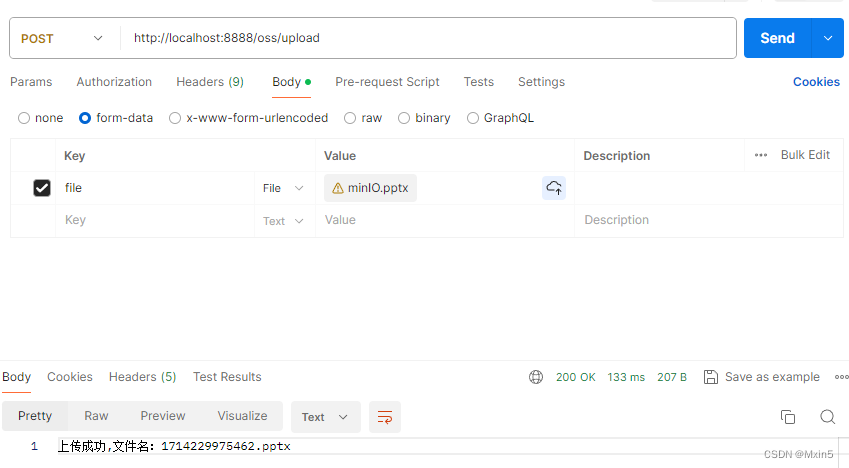
测试结果:

从minio中下载文件
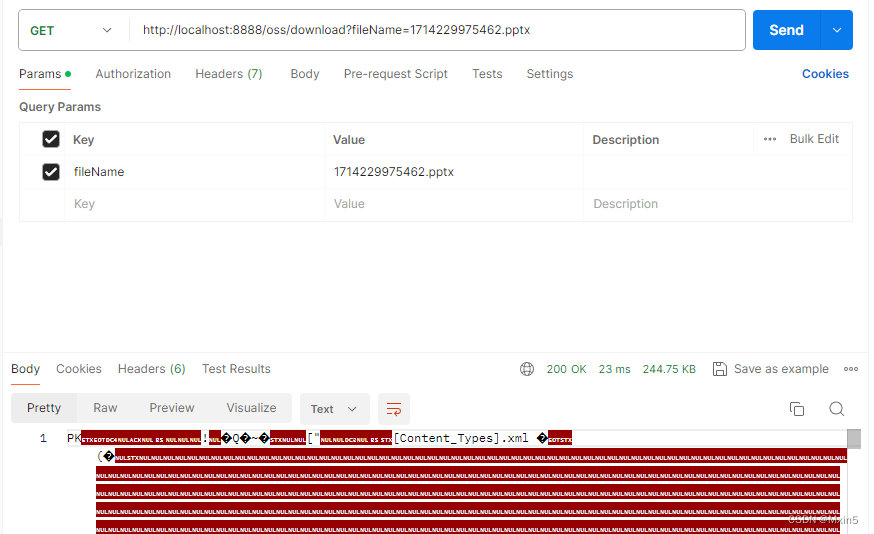

直接下载即可,这样就完成了从minio中下载指定文件,还有部分接口,如果感兴趣的小伙伴可以自行测试看下实际效果。
综上所有的代码就简单的介绍了一下Java实现文件上传和下载,希望能给你们实际开发带来一定的帮助,如果有出现问题的地方,希望指出,便于后续修改。
所有源码均以上传至https://download.csdn.net/download/m0_64210833/89233948


